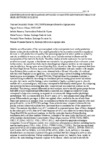Use este identificador para citar ou linkar para este item:
http://www.alice.cnptia.embrapa.br/alice/handle/doc/908744| Título: | Identification of mechanisms involved in mastitis response by means of gene network building. |
| Autoria: | GOZZO, V. C.  OKURA, V. K.   FONSECA, I.   MARTINS, M. F.   CARDOSO, F. F.   GIACHETTO, P. F.   |
| Afiliação: | VINÍCIUS CAMPIDELLI GOZZO, Unicamp/CNPTIA; VAGNER KATSUMI OKURA, Unicamp; ISABELA FONSECA, UFV; MARTA FONSECA MARTINS, CNPGL; FERNANDO FLORES CARDOSO, CPPSUL; POLIANA FERNANDA GIACHETTO, CNPTIA. |
| Ano de publicação: | 2011 |
| Referência: | In: INTERNATIONAL CONFERENCE OF THE BRAZILIAN ASSOCIATION FOR BIOINFORMATICS AND COMPUTATIONAL BIOLOGY, 7.; INTERNATIONAL CONFERENCE OF THE IBEROAMERICAN SOCIETY FOR BIOINFORMATICS, 3., 2011, Florianópolis. Proceedings... Florianópolis: Associação Brasileira de Bioinformática e Biologia Computacional, 2011. |
| Páginas: | Não paginado. |
| Conteúdo: | Mastitis, an inflammation of the mammary gland, is the most prevalent and costly production disease in dairy herds worldwide. It is caused generally by bacteria and accounts for a significant decrease in milk production and quality. One promising approach to reduce problems caused by mastitis, in addition to sanitary care, is the selection of animals resistant to disease and the incorporation of this trait into the herds. Therefore, studies to better understand the mechanisms involved in animal response to this disease are essential to the proposition of new advances in area. In this context, the aim of this study was to identify groups of genes involved in cow response to mastitis infection, through gene network building from microarray data. Gene expression data from the GeneChipâ Bovine Genome Array (Affymetrix) hybridization with milk somatic cells samples from Holstein-Zebu crossbreed dairy cows, obtained before (B) and 24 hrs after (A) artificial infection with Staphylococcus agalactiae, were analyzed using a network building methodology based on gene co-expression. We used WGCNA (Weighted Gene Co-expression Analysis), a systems biology method for describing the correlation patterns among genes across microarray samples, that can be used for finding clusters (modules) of highly correlated genes to identify modules of co-expressed genes, which may correspond to functionally related genes. By comparing two networks (between contrasting data sets), conserved and non-conserved modules can be identified. This strategy, named differential network analysis, aims to identify genes groups that are both differentially expressed and differentially connected, and changes in connectivity may correspond to large-scale rewiring, in response to environmental changes and/or physiologic perturbations. Two microarray data sets, B (n=5) and A (n=5), were preprocessed using affy and gcrma R/Bioconductor packages. A filter was applied, which resulted in the use of only those transcripts present in all samples. Gene co-expression networks were identified separately for each group (B and A), by the R/WGCNA package. Gene networks were compared between the two groups, and non-conserved modules were uncovered from a correlation test of the connectivity values. Our analysis identified a total of 17 modules of co-expressed genes, three of them, designed by the colors grey (n=35), blue (n=37) and turquoise (n=192), non-conserved between the groups. Using Blast2GO for enrichment analysis, we find the molecular function Protein Binding overrepresented in all three modules. However, in despite of the same molecular function, each one of the modules showed distinct characteristcs. Genes of grey module (BTG3, CD3E, MBD1, CHIC2, PLXNA3, MOCS3, NEIL1, VPS45, BCL2) were related to apoptosis and antigen recognition. Genes of turquoise module were enriched in inflammation mediators, including known mastitis marker genes (FGL1, GJA1, F2RL1, PTPRF, S100A2, TGFB2). The blue one uncovered genes involved in cell division and inflammatory response (CD97, MAD2L1, ZFP106, CDKN2C, LOC514364, NOP14, PCBD1, LOC100139798, AP1S1, EDN1, IL1B, ANXA11). Our study identified some mechanisms (represented by gene modules) that have changed in cows in early response to mastitis infection. Further analysis are being carried out, based on these results, to advance the understanding of animals response to the disease, which can lead to identify the candidate genes that could be used in breeding programs. |
| NAL Thesaurus: | Mastitis Gene expression |
| Palavras-chave: | Mastite Expressão gênica |
| Notas: | X-MEETING 2011. |
| Tipo do material: | Resumo em anais e proceedings |
| Acesso: | openAccess |
| Aparece nas coleções: | Resumo em anais de congresso (CNPTIA)  |
Arquivos associados a este item:
| Arquivo | Descrição | Tamanho | Formato | |
|---|---|---|---|---|
| mastitis.pdf | 39,14 kB | Adobe PDF |  Visualizar/Abrir |









